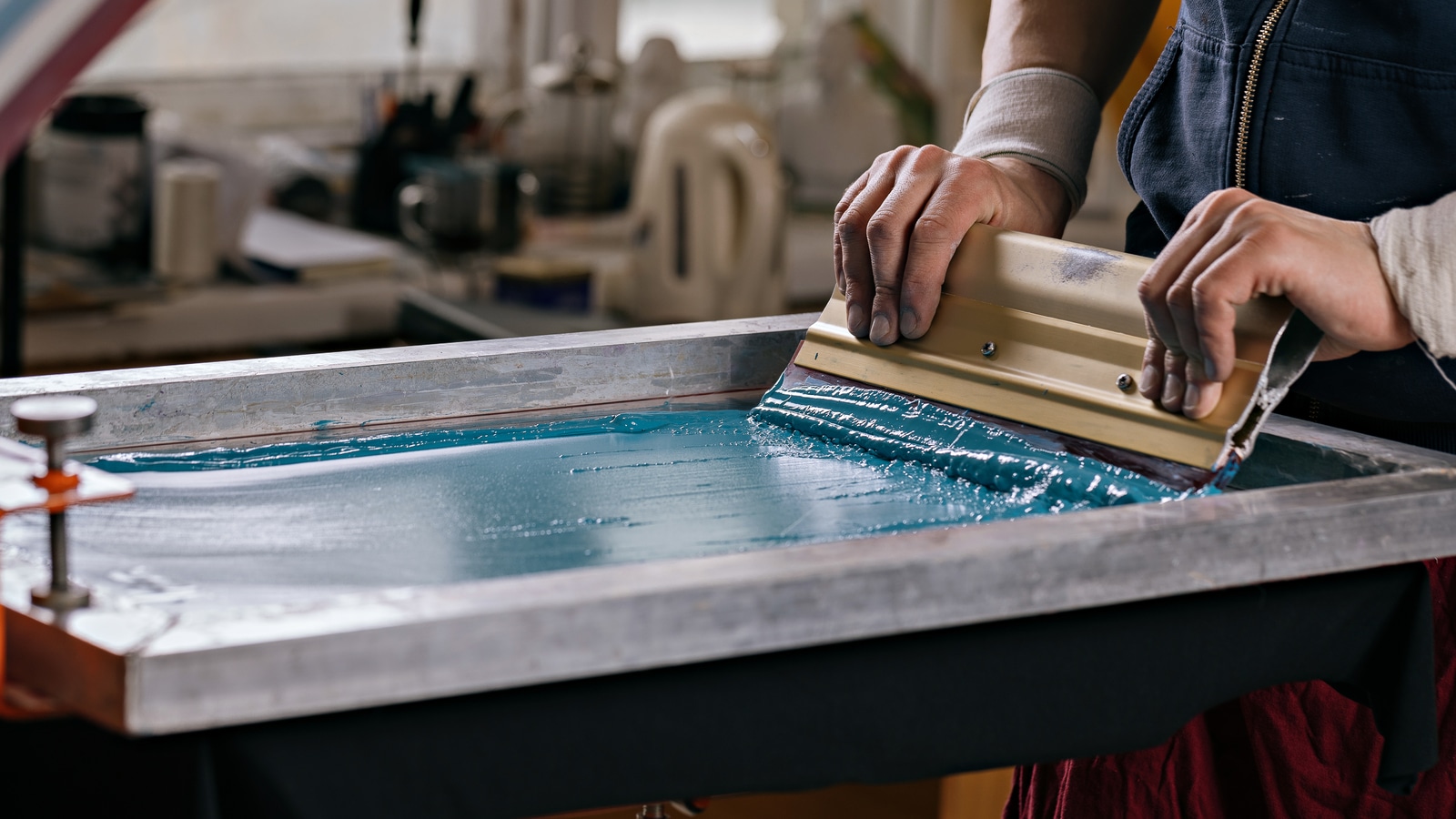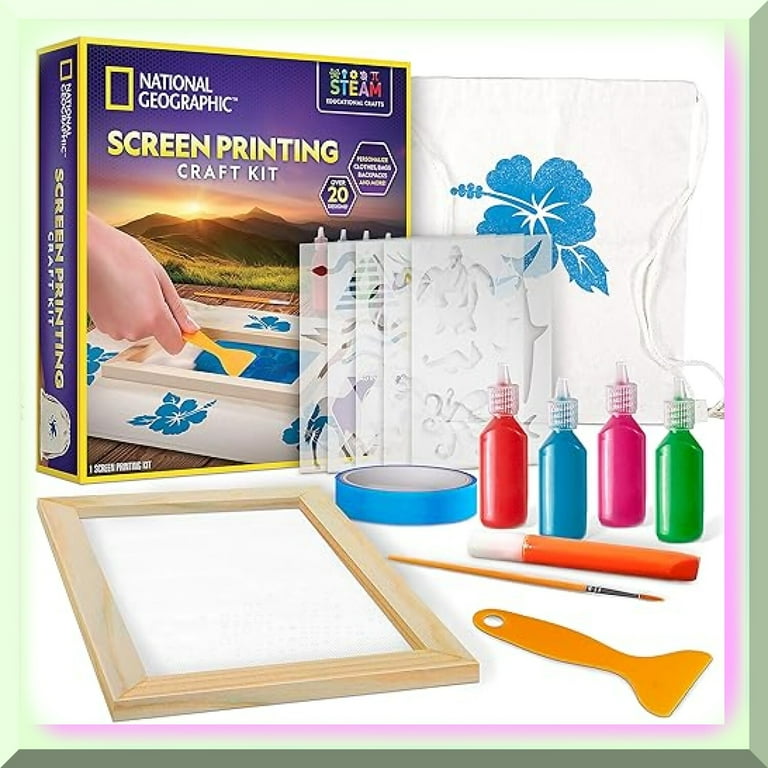Detailed Silk Screen Printing for Custom Art Apparel
Detailed Silk Screen Printing for Custom Art Apparel
Blog Article
Display Printing Uncovered: Every Little Thing You Required to Understand About T-Shirt and Garment Printing Techniques
Display printing is a fascinating method that combines art with method, using countless opportunities for creativity. Prepared to check out the important elements that make display publishing an art kind?
The Essentials of Screen Printing: Exactly How It Works
When you plunge into display printing, you'll uncover it's both an art and a scientific research. At its core, display printing entails creating a pattern, or display, that permits ink to travel through only in particular areas (screen printing kit). You begin by selecting your layout and preparing your display with a light-sensitive solution. Once you reveal this emulsion to light, it hardens, leaving your design as an adverse area.
Position the screen over the textile, after that use a squeegee to press ink with the screen onto the garment. Each action is crucial, and understanding them will elevate your display printing skills, changing straightforward garments right into distinct, expressive pieces.
Kinds Of Screen Printing Strategies
As soon as you realize the basics of display printing, it's time to explore the numerous strategies that can boost your layouts. One preferred method is standard screen printing, where ink is pushed with a stenciled screen.
If you're going for fine details, think about discharge printing. This strategy gets rid of color from the fabric, leaving a soft, classic look. Another alternative is plastisol printing, understood for its sturdiness and vibrant shades, making it a favored for many brands. Experiment with halftone printing to develop slope impacts and detailed designs. Each method has its unique appeal, so don't think twice to try them bent on find what suits your design best!
Important Equipment for Display Printing
To accomplish magnificent outcomes in display printing, having the best equipment is fundamental. You'll require a durable display printing frame, which holds the mesh that moves your design onto the garment. Next, spend in top quality mops; these are important for applying ink equally across the screen. You'll additionally need a great direct exposure unit to create your screens, as well as a washout booth for cleansing them after use. A trusted heat source, like a conveyor clothes dryer or heat press, is crucial for curing your prints to guarantee longevity. Don't neglect an appropriate work space, geared up with tables and storage space for your supplies. Ultimately, safety gear, such as masks and handwear covers, will certainly keep you safe from chemicals and inks. With the right tools, you'll be well on your method to producing professional-quality prints.
Selecting the Right Inks and Materials
When selecting inks and materials for display printing, you require to take into account the kind of ink that functions ideal for your task. Think regarding textile compatibility to assure your designs look terrific and last lengthy. Discover green ink alternatives to make your printing procedure more lasting.
Kinds Of Screen Inks
Selecting the right screen ink is important for accomplishing dynamic, durable prints that satisfy your job's demands. There are a number of types of display inks to take a look at. Plastisol ink is popular for its adaptability and convenience of use, giving superb shade opacity on dark textiles. Water-based ink, on the various other hand, offers a softer feeling and is environmentally friendly, making it suitable for those looking to reduce their environmental influence. Release inks remove color from the fabric, causing a soft, vintage look however need particular handling. Finally, specialty inks, such as metal or glow-in-the-dark, can add unique impacts to your layouts. Review your job requirements and choose the ink that straightens finest with your preferred result.

Material Compatibility Considerations
Recognizing material compatibility is crucial for achieving high-grade display prints, particularly given that various products respond distinctly to different inks. Constantly test your inks on sample textile to assure they adhere properly and preserve shade honesty. In addition, keep in mind that material weight and texture can influence the last outcome, so picking the right ink and material combination is essential for your project's success.
Eco-Friendly Ink Options
Eco-friendly inks are coming to be a popular option for screen printers that want to decrease their environmental impact while preserving top quality. When selecting inks, consider water-based inks, which are less dangerous and much easier to clean up contrasted to typical solvents.
Furthermore, search for inks made from renewable resources, such as soy or vegetable-based options. By choosing the best inks and products, you'll not just develop spectacular designs however also add to an extra lasting printing process. Make the button, and your prints will certainly show your commitment to the environment!
Preparing Your Style for Display Printing

Submit Style Demands
To assure your layout looks vivid and sharp on textile, you'll require to pay attention to submit style requirements for display printing. Begin with vector documents like AI or EPS, as they can be scaled without losing high quality. If you make use of raster images, go with high-resolution data, such as TIFF or PNG, preferably at 300 DPI. Avoid making use of JPEGs, as they can shed quality when useful site resized. Likewise, make certain your design has a transparent history to protect against undesirable white sides on your prints. Ultimately, maintain shade modes in mind; CMYK is common for display printing, so transform your RGB designs accordingly. By following these guidelines, you'll establish your art work up for an effective print.
Color Separation Methods
Shade splitting up is a crucial action in preparing your design for display printing, and mastering it can substantially boost your print top quality. You'll require to break your design into specific colors, as each color requires a different screen throughout printing. This accuracy not only ensures exact color representation but likewise simplifies the printing process.
Resolution and Dimension
Achieving the very best cause display printing begins with guaranteeing your layout has the appropriate resolution and dimension. Preferably, your artwork needs to go to the very least 300 DPI (dots per inch) for sharp, clear prints. If you use reduced resolution, your final item may look unprofessional and pixelated.
When it pertains to dimension, think about the measurements of your print location. Style your artwork to match the final print dimension, ideally developing it in the actual dimensions you'll be printing. This means, you'll prevent any type of unanticipated scaling concerns.
Constantly inspect your design in both vector and raster styles. Vector graphics can be scaled without shedding quality, making them suitable for display printing. Preparing correctly will assure your style looks outstanding on every garment!
Step-by-Step Screen Printing Process
Screen printing is a vibrant process that allows you to create vibrant styles on different surfaces. To obtain started, you'll need a display, emulsion, and your picked ink.
After cleaning out the unexposed solution, your screen prepares. Set it up on your printing surface and straighten your garment below it. Put ink onto the screen and utilize a squeegee to press the ink via the pattern onto the textile. Lift the display carefully and let the print completely dry. Cure the ink making use of heat to guarantee durability. That's it! You have actually efficiently display printed your style.
Tips for Successful Display Printing Projects
While you're diving into your display printing projects, keep in mind that prep work is key to success. Beginning by gathering all your materials-- inks, mops, click to investigate displays, and garments. A tidy work space assists stop unwanted errors, so clean up prior to you begin.
Next, verify your art work is high-resolution and properly sized for your garment. Test your screen for appropriate direct exposure and tidy it extensively to stay clear of spots. When blending your inks, follow the supplier's guidelines to attain the right uniformity.
Throughout printing, apply also stress with your squeegee for consistent outcomes. Do not hurry; take your time to validate each print meets your standards. After printing, let your garments completely dry entirely prior to dealing with or packaging them.
Last but not least, always maintain a sample of your help future referral. By doing this, you can analyze your progress and improve your methods with time. Satisfied printing!

Frequently Asked Inquiries
How much time Does It Take to Establish a Screen Printing Work?
Establishing a display printing task typically takes about thirty minutes to an hour. You'll prepare the displays, mix inks, and readjust the press. The moment differs based upon intricacy and experience, so remain organized!
Can I Print on Various Fabric Types Making Use Of the Exact Same Technique?
Yes, you can print on various fabric types making use of the same strategy, yet you'll need to change your inks and settings. Some materials take in ink in different ways, so trying out guarantees the very best results for each and every material.
What Prevail Blunders to Stay Clear Of in Display Printing?
When screen printing, avoid typical errors like using the wrong ink, disregarding appropriate exposure times, or missing pre-press checks. Constantly test your arrangement and preserve clean displays to guarantee quality outcomes each time.
Just How Can I Effectively Tidy and Maintain My Screen Printing Tools?
To correctly clean and keep your screen printing tools, you need to frequently clean screens with proper solvents, inspect squeegees for wear, and guarantee all tools are saved dust-free and completely dry. Uniformity improves and protects against pricey fixings performance.
Is Screen Printing Eco Friendly Contrasted to Other Approaches?
Screen printing can be a lot more eco-friendly than various other methods, especially if you use water-based inks and eco-conscious materials. By selecting lasting products and techniques, you lower waste and reduce your effect on the world.
Display Printing Uncovered: Whatever You Required to Know About Tee and Garment Printing Methods
At its core, screen printing entails developing a stencil, or screen, that allows ink to pass with just in specific areas. Placement the screen over the fabric, after that utilize a squeegee to push ink through the display onto the garment. One preferred technique is traditional display printing, where ink is pushed through a stenciled display.When picking inks and materials for screen printing, you need to take right into account the kind of ink that works ideal for your job.
Report this page